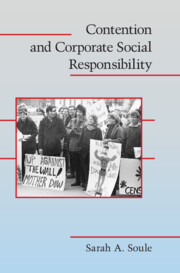Book contents
- Frontmatter
- Contents
- Figures
- Tables
- Preface
- 1 INTRODUCTION
- 2 UNDERSTANDING SOCIAL MOVEMENTS, CONTENTIOUS AND PRIVATE POLITICS, AND THEIR CONSEQUENCES
- 3 ANTICORPORATE PROTEST IN THE UNITED STATES, 1960–1990
- 4 THE EFFECT OF PROTEST ON UNIVERSITY DIVESTMENT
- 5 PRIVATE AND CONTENTIOUS POLITICS IN THE POST-1990 ERA
- 6 CONCLUSION
- Appendix A Description of Data Used in Chapter 3
- Appendix B Modeling Technique Used in Chapter 3
- Appendix C Sources of Data for Analysis in Chapter 4
- Appendix D Modeling Technique Used in Chapter 4
- Bibliography
- Index
Appendix A - Description of Data Used in Chapter 3
Published online by Cambridge University Press: 05 June 2012
- Frontmatter
- Contents
- Figures
- Tables
- Preface
- 1 INTRODUCTION
- 2 UNDERSTANDING SOCIAL MOVEMENTS, CONTENTIOUS AND PRIVATE POLITICS, AND THEIR CONSEQUENCES
- 3 ANTICORPORATE PROTEST IN THE UNITED STATES, 1960–1990
- 4 THE EFFECT OF PROTEST ON UNIVERSITY DIVESTMENT
- 5 PRIVATE AND CONTENTIOUS POLITICS IN THE POST-1990 ERA
- 6 CONCLUSION
- Appendix A Description of Data Used in Chapter 3
- Appendix B Modeling Technique Used in Chapter 3
- Appendix C Sources of Data for Analysis in Chapter 4
- Appendix D Modeling Technique Used in Chapter 4
- Bibliography
- Index
Summary
The data used in Chapter 3 were collected from daily editions of the New York Times (NYT) as part of a larger research project initiated by myself along with Doug McAdam, John McCarthy, and Susan Olzak (see McAdam and Su 2002; Earl, Soule, and McCarthy 2003; Van Dyke, Soule, and Taylor 2004; Soule and Earl 2005; Earl and Soule 2006; King and Soule 2007; King, Soule, and Bentele 2007; Soule and King 2008; Larson and Soule 2009; Olzak and Soule 2009; and Soule and Davenport 2009 for descriptions of the larger project).
In 1997, armed with a team of National Science Foundation-funded research assistants, we launched the project with the ambitious goal of searching the daily editions of the NYT for any mention of any kind of collective protest taking place in the United States during this thirty-one-year period. In order to be included in our dataset, events had to meet several criteria: 1) more than one person had to participate in an event because our concern was with collective action and not individual acts of protest (e.g., self-immolation or uncoordinated hunger strikes); 2) participants must have articulated some claim, whether it be against some target, or in favor of some target (i.e., we exclude collective gatherings that did not explicitly articulate a claim, such as block parties, annual parades, outdoor concerts, and so on); and 3) the event must have happened in the public sphere (i.e., we exclude private meetings by social movement actors such as organizing and strategy sessions, but we do include events occurring inside of buildings so long as they were open to the public).
- Type
- Chapter
- Information
- Contention and Corporate Social Responsibility , pp. 161 - 163Publisher: Cambridge University PressPrint publication year: 2009



